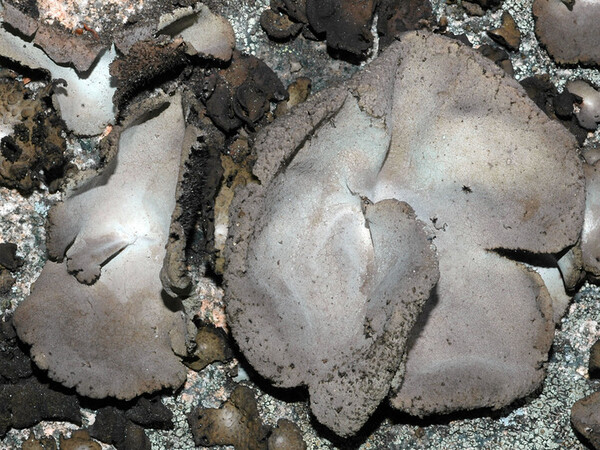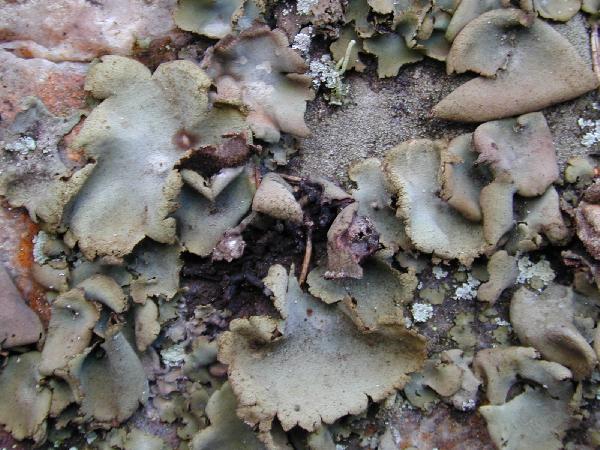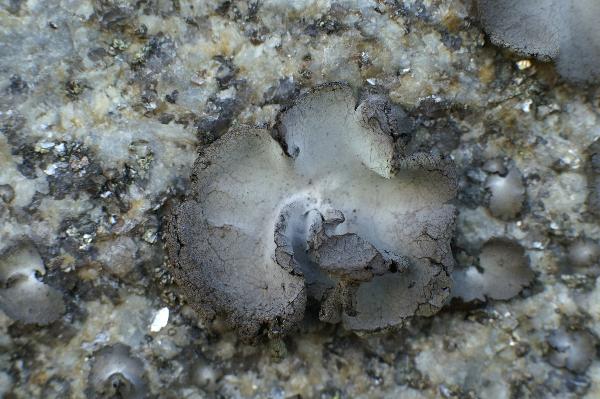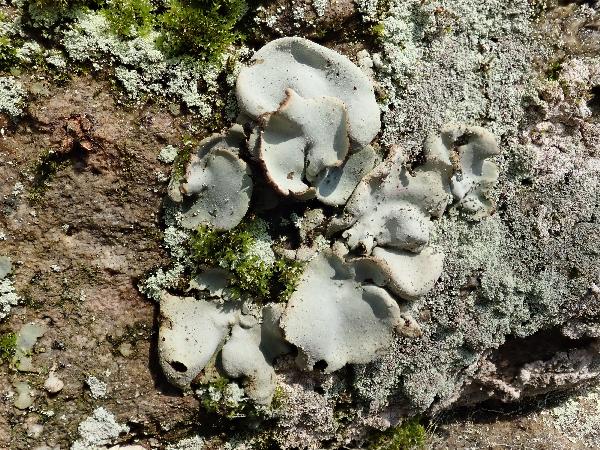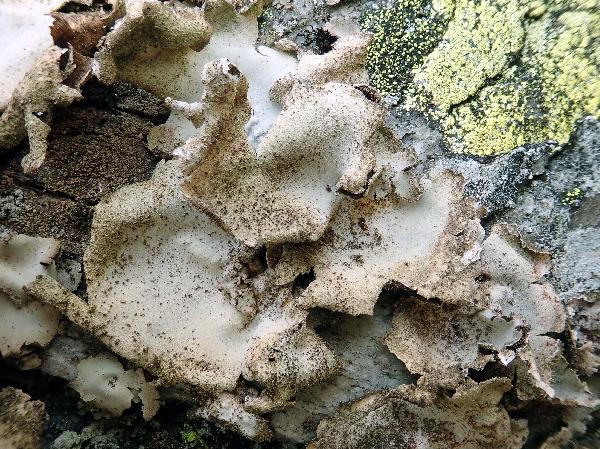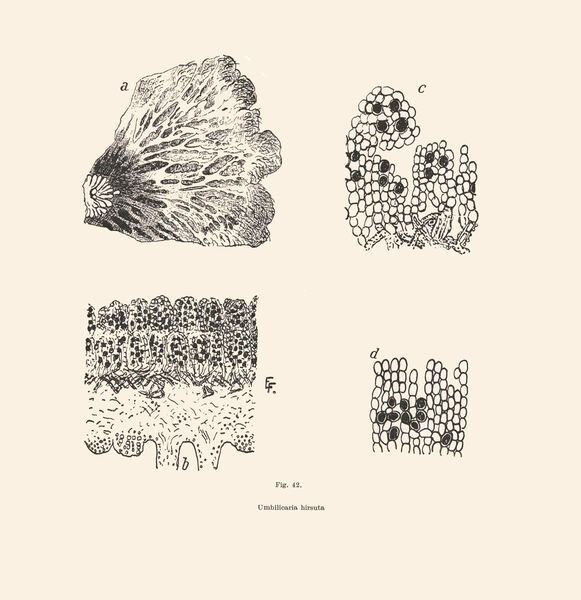Umbilicaria hirsuta (Westr.) Ach.
K. Vetensk-Akad. Nya Handl., 15: 97, 1794. Basionym: Lichen hirsutus Sw. ex Westr. - K. Vetensk.-Akad. Nya Handl.: 47, 1793.
Synonyms: Gyrophora hirsuta (Westr.) Ach.; Gyrophora hirsuta var. melanotricha Flot.; Gyrophora hirsuta var. vestita Th. Fr.; Gyrophora vellea var. hirsuta (Westr.) Rabenh.
Distribution: N - Frl, TAA, Lomb (Valcuvia & al. 2003, Gheza 2019), Piem (Isocrono & Falletti 1999, Isocrono & al. 2003, Isocrono & Piervittori 2008, Lich. Ital. Exs. 43: Isocrono & al. 2020), VA (Piervittori & Isocrono 1997, 1999), Emil (Fariselli & al. 2020), Lig (TSB s.n.). C - Tosc, Sar. S - Bas (Potenza & al. 2014), Cal (Puntillo 1996), Si.
Description: Thallus foliose-umbilicate, heteromerous, dorsiventral, 2-5(-8) cm wide, monophyllous, rarely polyphyllous, of variable thickness, attached by a central holdfast, the margins often down-turned, rounded or lacerate. Upper surface grey to brownish grey with reddish spots, dull, rimose, scabrous, over the umbo covered with whitish areoles which become more and more distinctly powdery-sorediate toward margins. Lower surface medium brown to buff, slightly areolate, often darker around the umbilicus in old specimens, sometimes black, with darker trabeculae radiating from the umbilicus and sometimes reaching the margins; rhizinomorphs simple or moderately to densely branched, cylindrical, strap-like, absent around the umbilicus but otherwise usually abundant, concolorous or slightly darker; thalloconidia absent. Upper cortex paraplectenchymatous, 20-30 µm thick; medulla white, loose; lower cortex brown, scleroplectenchymatous, 20-60 µm thick. Apothecia rare, black, weakly gyrodisc, 0.5-2 mm across. Epithecium brown; hymenium colourless to brownish, often divided into compartments by columns of sterile tissue; paraphyses simple or sparingly branched, the apical cells more or less swollen; hypothecium thick, dark. Asci 8-spored, clavate, thick-walled, with an amyloid apical dome, Umbilicaria-type. Ascospores 1-celled, hyaline, ellipsoid, 10-14 x 3-8 µm. Photobiont chlorococcoid. Spot tests: medulla K-, C+ red, KC+ red, P-. Chemistry: medulla with gyrophoric acid and small amounts of lecanoric acid. Note: a widespread, arctic-alpine to boreal-montane, circumpolar lichen found on steeply inclined to slightly rain-sheltered surfaces of siliceous rocks, often in somehow dusty situations; common in the Alps, rarer in the Apennines and in the mountains of Sicily, also for the scarcity of suitable substrata.
Growth form: Foliose, umbilicate
Substrata: rocks
Photobiont: green algae other than Trentepohlia
Reproductive strategy: mainly asexual, by soredia, or soredia-like structures (e.g. blastidia)
Commonnes-rarity: (info)
Alpine belt: common
Subalpine belt: very common
Oromediterranean belt: rather rare
Montane belt: rare
Submediterranean belt: extremely rare
Padanian area: absent
Humid submediterranean belt: extremely rare
Humid mediterranean belt: absent
Dry mediterranean belt: absent

Predictive model
Herbarium samples
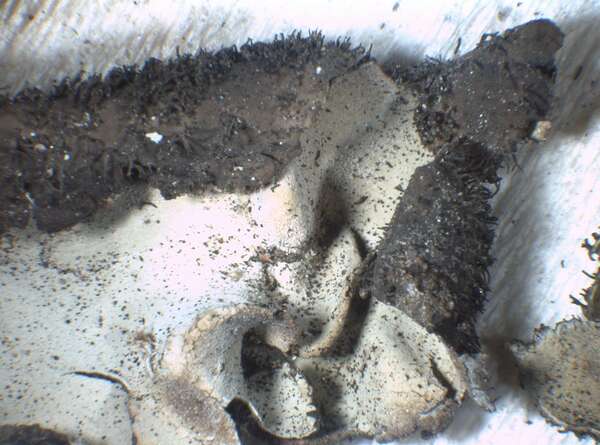

P.L. Nimis; Owner: Department of Life Sciences, University of Trieste
Herbarium: TSB (10900)
2003/03/17
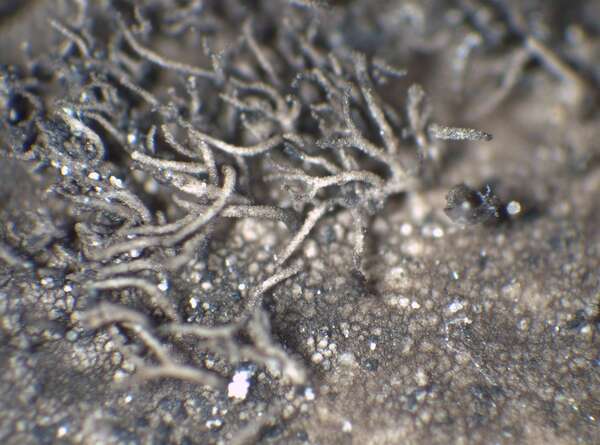

P.L. Nimis; Owner: Department of Life Sciences, University of Trieste
Herbarium: TSB (29192)
2003/03/17
detail of lower surface
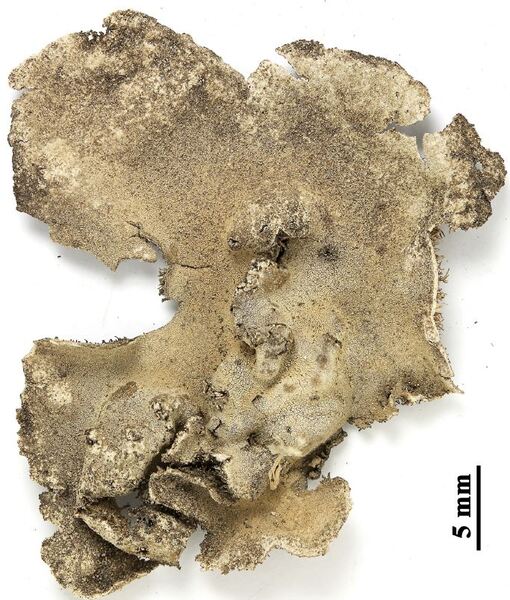

Felix Schumm - CC BY-SA 4.0
[GZU 54-88], Afghanistan, Paghman-Gebirge, oberhalb des Ortes Paghman, etwa 500 m unterhalb der Talgabelung Chap-Darrah und Rast-Darrah, 68°56’ E, 34°37’ N, ca. 2540 m. an Silikatfelsen. Leg. D. Podlech (57/5), 10.04.1977. LICHENOTHECA AFRICANA NR. 56
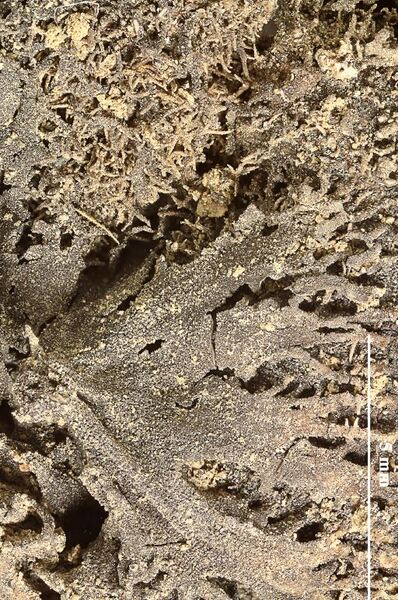

Felix Schumm - CC BY-SA 4.0
[GZU 54-88], Afghanistan, Paghman-Gebirge, oberhalb des Ortes Paghman, etwa 500 m unterhalb der Talgabelung Chap-Darrah und Rast-Darrah, 68°56’ E, 34°37’ N, ca. 2540 m. an Silikatfelsen. Leg. D. Podlech (57/5), 10.04.1977. LICHENOTHECA AFRICANA NR. 56
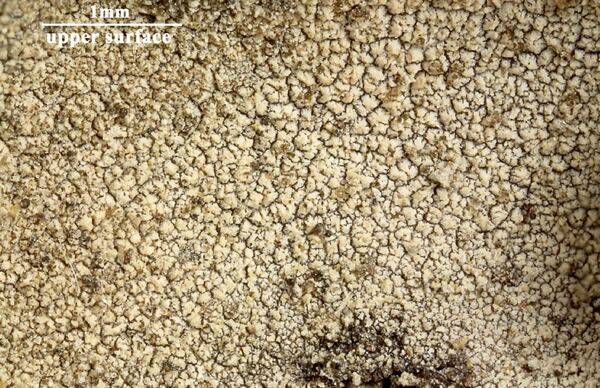

Felix Schumm - CC BY-SA 4.0
[GZU 54-88], Afghanistan, Paghman-Gebirge, oberhalb des Ortes Paghman, etwa 500 m unterhalb der Talgabelung Chap-Darrah und Rast-Darrah, 68°56’ E, 34°37’ N, ca. 2540 m. an Silikatfelsen. Leg. D. Podlech (57/5), 10.04.1977. LICHENOTHECA AFRICANA NR. 56
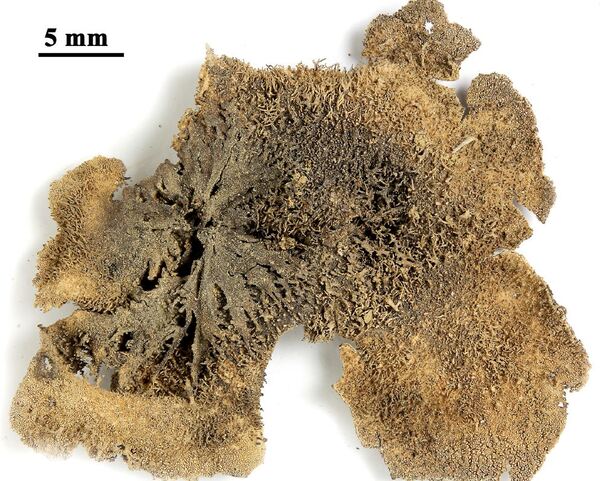

Felix Schumm - CC BY-SA 4.0
[GZU 54-88], Afghanistan, Paghman-Gebirge, oberhalb des Ortes Paghman, etwa 500 m unterhalb der Talgabelung Chap-Darrah und Rast-Darrah, 68°56’ E, 34°37’ N, ca. 2540 m. an Silikatfelsen. Leg. D. Podlech (57/5), 10.04.1977. LICHENOTHECA AFRICANA NR. 56
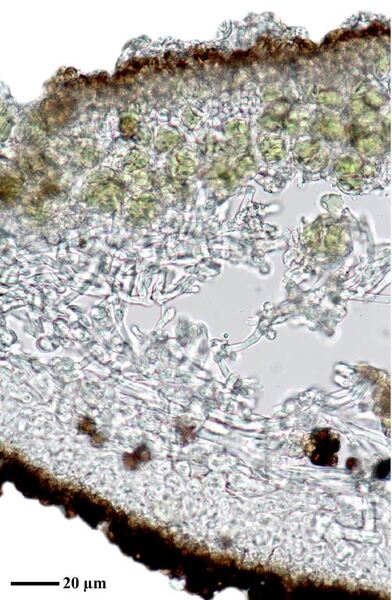

Felix Schumm - CC BY-SA 4.0
[GZU 54-88], Afghanistan, Paghman-Gebirge, oberhalb des Ortes Paghman, etwa 500 m unterhalb der Talgabelung Chap-Darrah und Rast-Darrah, 68°56’ E, 34°37’ N, ca. 2540 m. an Silikatfelsen. Leg. D. Podlech (57/5), 10.04.1977. LICHENOTHECA AFRICANA NR. 56


Felix Schumm - CC BY-SA 4.0
[GZU 54-88], Afghanistan, Paghman-Gebirge, oberhalb des Ortes Paghman, etwa 500 m unterhalb der Talgabelung Chap-Darrah und Rast-Darrah, 68°56’ E, 34°37’ N, ca. 2540 m. an Silikatfelsen. Leg. D. Podlech (57/5), 10.04.1977. LICHENOTHECA AFRICANA NR. 56


Felix Schumm - CC BY-SA 4.0
[GZU 54-88], Afghanistan, Paghman-Gebirge, oberhalb des Ortes Paghman, etwa 500 m unterhalb der Talgabelung Chap-Darrah und Rast-Darrah, 68°56’ E, 34°37’ N, ca. 2540 m. an Silikatfelsen. Leg. D. Podlech (57/5), 10.04.1977. LICHENOTHECA AFRICANA NR. 56
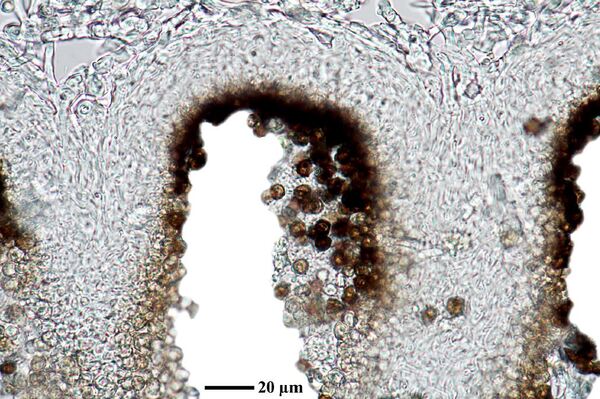

Felix Schumm - CC BY-SA 4.0
[GZU 54-88], Afghanistan, Paghman-Gebirge, oberhalb des Ortes Paghman, etwa 500 m unterhalb der Talgabelung Chap-Darrah und Rast-Darrah, 68°56’ E, 34°37’ N, ca. 2540 m. an Silikatfelsen. Leg. D. Podlech (57/5), 10.04.1977. LICHENOTHECA AFRICANA NR. 56
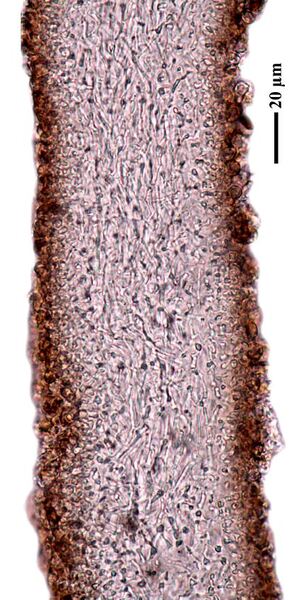

Felix Schumm - CC BY-SA 4.0
[GZU 54-88], Afghanistan, Paghman-Gebirge, oberhalb des Ortes Paghman, etwa 500 m unterhalb der Talgabelung Chap-Darrah und Rast-Darrah, 68°56’ E, 34°37’ N, ca. 2540 m. an Silikatfelsen. Leg. D. Podlech (57/5), 10.04.1977. LICHENOTHECA AFRICANA NR. 56
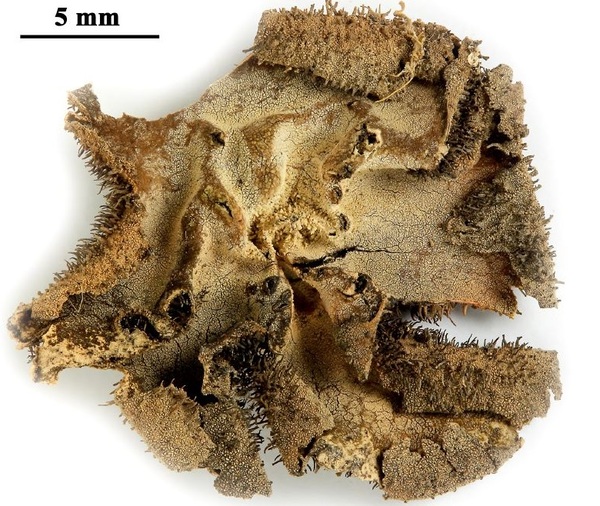

Felix Schumm - CC BY-SA 4.0
[LIAF_17], Afghanistan, Prov. Kabul, Paghman-Gebirge, oberhalb des Ortes Paghman, an der Talgabelung Chap-Darrah und Rast-Darrah, 68°56’ E, 34°37’ N, ca. 2550 m, steile Silikatfelsen, N-NW-exponiert. Leg. M. Steiner (37/2, 59/4), 30.05., 21.06.1970. LICHENOTHECA AFGHANICA NR. 17.
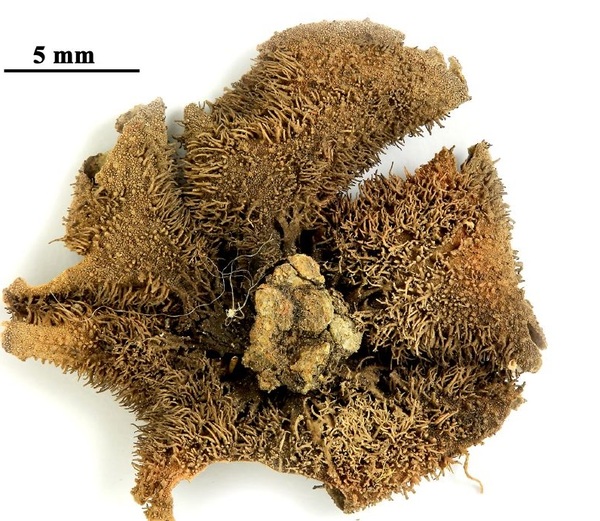

Felix Schumm - CC BY-SA 4.0
[LIAF_17], Afghanistan, Prov. Kabul, Paghman-Gebirge, oberhalb des Ortes Paghman, an der Talgabelung Chap-Darrah und Rast-Darrah, 68°56’ E, 34°37’ N, ca. 2550 m, steile Silikatfelsen, N-NW-exponiert. Leg. M. Steiner (37/2, 59/4), 30.05., 21.06.1970. LICHENOTHECA AFGHANICA NR. 17.
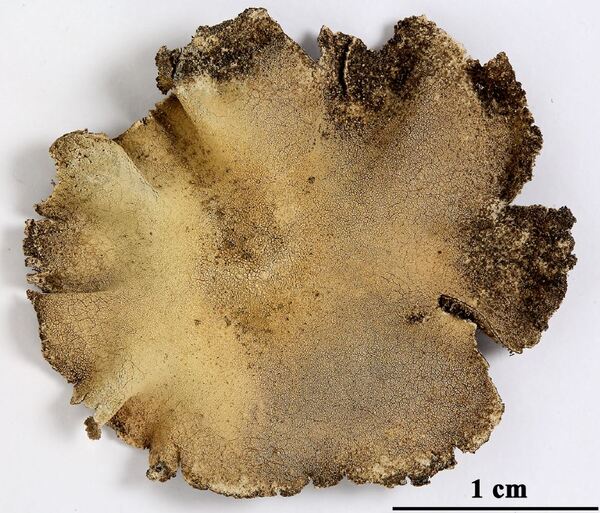

Felix Schumm - CC BY-SA 4.0
[LIAF_56], Afghanistan, Prov. Kabul, Paghman-Gebirge, oberhalb des Ortes Paghman, etwa 500 m unterhalb der Talgabelung Chap-Darrah und Rast-Darrah, 68°56’ E, 34°37’ N, ca. 2540 m, Silikatfelsen. Leg. D. Podlech (Pod 57/5), 10.04.1977. LICHENOTHECA AFGHANICA NR. 56.
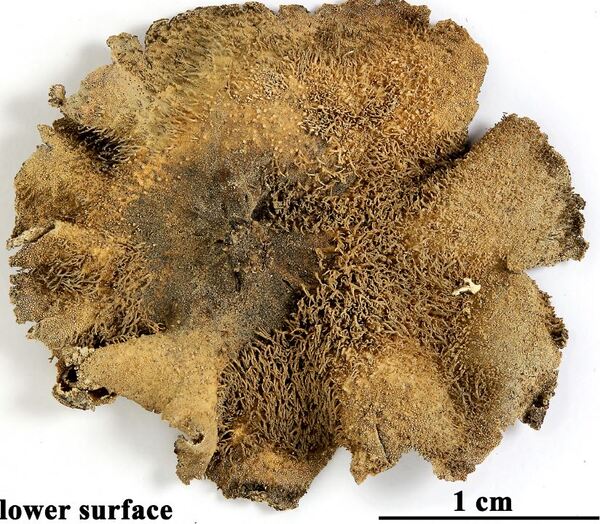

Felix Schumm - CC BY-SA 4.0
[LIAF_56], Afghanistan, Prov. Kabul, Paghman-Gebirge, oberhalb des Ortes Paghman, etwa 500 m unterhalb der Talgabelung Chap-Darrah und Rast-Darrah, 68°56’ E, 34°37’ N, ca. 2540 m, Silikatfelsen. Leg. D. Podlech (Pod 57/5), 10.04.1977. LICHENOTHECA AFGHANICA NR. 56.
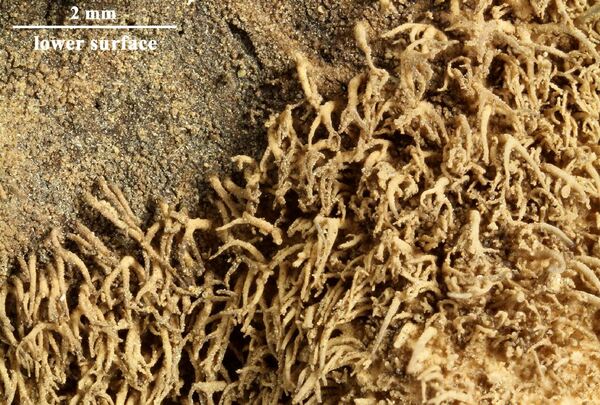

Felix Schumm - CC BY-SA 4.0
[LIAF_56], Afghanistan, Prov. Kabul, Paghman-Gebirge, oberhalb des Ortes Paghman, etwa 500 m unterhalb der Talgabelung Chap-Darrah und Rast-Darrah, 68°56’ E, 34°37’ N, ca. 2540 m, Silikatfelsen. Leg. D. Podlech (Pod 57/5), 10.04.1977. LICHENOTHECA AFGHANICA NR. 56.
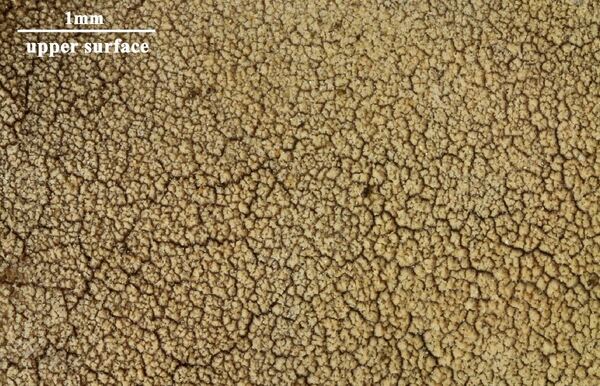

Felix Schumm - CC BY-SA 4.0
[LIAF_56], Afghanistan, Prov. Kabul, Paghman-Gebirge, oberhalb des Ortes Paghman, etwa 500 m unterhalb der Talgabelung Chap-Darrah und Rast-Darrah, 68°56’ E, 34°37’ N, ca. 2540 m, Silikatfelsen. Leg. D. Podlech (Pod 57/5), 10.04.1977. LICHENOTHECA AFGHANICA NR. 56.
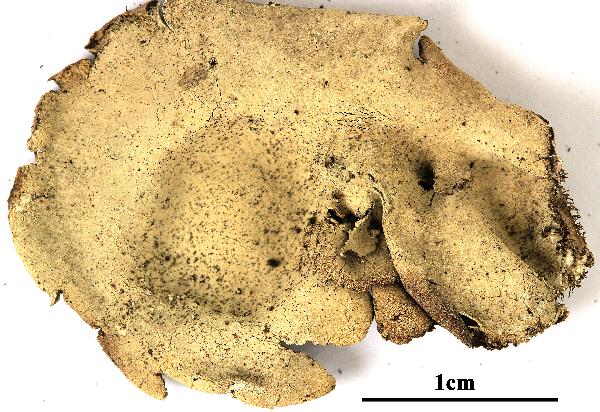

Felix Schumm - CC BY 4.0
[1536], Riesengebirge Oberschreiberhau, am Marienstein, 700 m. Leg.
J. Hillmann, 1933, det. E. Frey. Ex Herbario E. Frey (Nr. 3997).
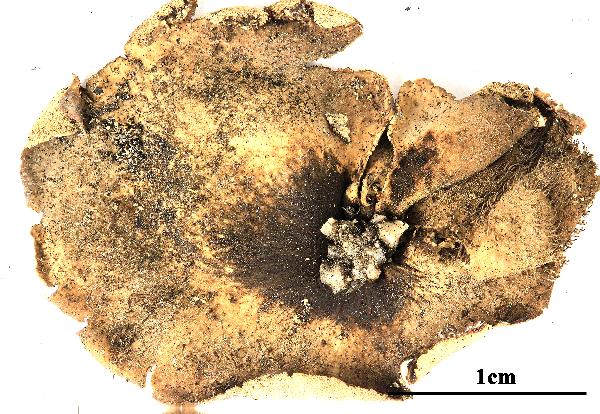

Felix Schumm - CC BY 4.0
[1536], Riesengebirge Oberschreiberhau, am Marienstein, 700 m. Leg.
J. Hillmann, 1933, det. E. Frey. Ex Herbario E. Frey (Nr. 3997).


Felix Schumm - CC BY 4.0
[1537], Finnland, Nylandia, Helsinki, Viikki, Agraarikylä E-; on the
rockface in the forest. Leg. Pentti Alanko, 29.09.1968, det. P. Alanko.
Ex Plantae Fennicae.


Felix Schumm - CC BY 4.0
[1537], Finnland, Nylandia, Helsinki, Viikki, Agraarikylä E-; on the
rockface in the forest. Leg. Pentti Alanko, 29.09.1968, det. P. Alanko.
Ex Plantae Fennicae.
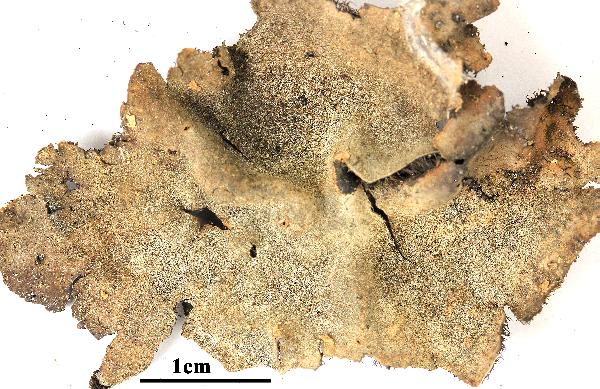

Felix Schumm - CC BY 4.0
[2799], Spanien, Kanarische Inseln, Tenerife: zerstreut unter anderen
Nabelflechten an wechselfeuchten halbschattigen Steil- und Stirnflächen
von Ergußgestein im Umbilicarietum hirsutae, 2300 m, pH 6.5,
Nordabsturz der Montaña de Guajara am Südrand der Cañadas. Leg. et
det. G. Follmann, 04.1979. EX G. FOLLMANN: LICHENES EXSICCXATI
SELECTI A MUSEO HISTORIAE NATURALIS CASSELENSI EDITI NR. 300.


Felix Schumm - CC BY 4.0
[2799], Spanien, Kanarische Inseln, Tenerife: zerstreut unter anderen
Nabelflechten an wechselfeuchten halbschattigen Steil- und Stirnflächen
von Ergußgestein im Umbilicarietum hirsutae, 2300 m, pH 6.5,
Nordabsturz der Montaña de Guajara am Südrand der Cañadas. Leg. et
det. G. Follmann, 04.1979. EX G. FOLLMANN: LICHENES EXSICCXATI
SELECTI A MUSEO HISTORIAE NATURALIS CASSELENSI EDITI NR. 300.
Growth form: Foliose, umbilicate
Substrata: rocks
Photobiont: green algae other than Trentepohlia
Reproductive strategy: mainly asexual, by soredia, or soredia-like structures (e.g. blastidia)
Commonnes-rarity: (info)
Alpine belt: common
Subalpine belt: very common
Oromediterranean belt: rather rare
Montane belt: rare
Submediterranean belt: extremely rare
Padanian area: absent
Humid submediterranean belt: extremely rare
Humid mediterranean belt: absent
Dry mediterranean belt: absent

Predictive model
| Herbarium samples |


P.L. Nimis; Owner: Department of Life Sciences, University of Trieste
Herbarium: TSB (10900)
2003/03/17


P.L. Nimis; Owner: Department of Life Sciences, University of Trieste
Herbarium: TSB (29192)
2003/03/17
detail of lower surface


Felix Schumm - CC BY-SA 4.0
[GZU 54-88], Afghanistan, Paghman-Gebirge, oberhalb des Ortes Paghman, etwa 500 m unterhalb der Talgabelung Chap-Darrah und Rast-Darrah, 68°56’ E, 34°37’ N, ca. 2540 m. an Silikatfelsen. Leg. D. Podlech (57/5), 10.04.1977. LICHENOTHECA AFRICANA NR. 56


Felix Schumm - CC BY-SA 4.0
[GZU 54-88], Afghanistan, Paghman-Gebirge, oberhalb des Ortes Paghman, etwa 500 m unterhalb der Talgabelung Chap-Darrah und Rast-Darrah, 68°56’ E, 34°37’ N, ca. 2540 m. an Silikatfelsen. Leg. D. Podlech (57/5), 10.04.1977. LICHENOTHECA AFRICANA NR. 56


Felix Schumm - CC BY-SA 4.0
[GZU 54-88], Afghanistan, Paghman-Gebirge, oberhalb des Ortes Paghman, etwa 500 m unterhalb der Talgabelung Chap-Darrah und Rast-Darrah, 68°56’ E, 34°37’ N, ca. 2540 m. an Silikatfelsen. Leg. D. Podlech (57/5), 10.04.1977. LICHENOTHECA AFRICANA NR. 56


Felix Schumm - CC BY-SA 4.0
[GZU 54-88], Afghanistan, Paghman-Gebirge, oberhalb des Ortes Paghman, etwa 500 m unterhalb der Talgabelung Chap-Darrah und Rast-Darrah, 68°56’ E, 34°37’ N, ca. 2540 m. an Silikatfelsen. Leg. D. Podlech (57/5), 10.04.1977. LICHENOTHECA AFRICANA NR. 56


Felix Schumm - CC BY-SA 4.0
[GZU 54-88], Afghanistan, Paghman-Gebirge, oberhalb des Ortes Paghman, etwa 500 m unterhalb der Talgabelung Chap-Darrah und Rast-Darrah, 68°56’ E, 34°37’ N, ca. 2540 m. an Silikatfelsen. Leg. D. Podlech (57/5), 10.04.1977. LICHENOTHECA AFRICANA NR. 56


Felix Schumm - CC BY-SA 4.0
[GZU 54-88], Afghanistan, Paghman-Gebirge, oberhalb des Ortes Paghman, etwa 500 m unterhalb der Talgabelung Chap-Darrah und Rast-Darrah, 68°56’ E, 34°37’ N, ca. 2540 m. an Silikatfelsen. Leg. D. Podlech (57/5), 10.04.1977. LICHENOTHECA AFRICANA NR. 56


Felix Schumm - CC BY-SA 4.0
[GZU 54-88], Afghanistan, Paghman-Gebirge, oberhalb des Ortes Paghman, etwa 500 m unterhalb der Talgabelung Chap-Darrah und Rast-Darrah, 68°56’ E, 34°37’ N, ca. 2540 m. an Silikatfelsen. Leg. D. Podlech (57/5), 10.04.1977. LICHENOTHECA AFRICANA NR. 56


Felix Schumm - CC BY-SA 4.0
[GZU 54-88], Afghanistan, Paghman-Gebirge, oberhalb des Ortes Paghman, etwa 500 m unterhalb der Talgabelung Chap-Darrah und Rast-Darrah, 68°56’ E, 34°37’ N, ca. 2540 m. an Silikatfelsen. Leg. D. Podlech (57/5), 10.04.1977. LICHENOTHECA AFRICANA NR. 56


Felix Schumm - CC BY-SA 4.0
[GZU 54-88], Afghanistan, Paghman-Gebirge, oberhalb des Ortes Paghman, etwa 500 m unterhalb der Talgabelung Chap-Darrah und Rast-Darrah, 68°56’ E, 34°37’ N, ca. 2540 m. an Silikatfelsen. Leg. D. Podlech (57/5), 10.04.1977. LICHENOTHECA AFRICANA NR. 56


Felix Schumm - CC BY-SA 4.0
[LIAF_17], Afghanistan, Prov. Kabul, Paghman-Gebirge, oberhalb des Ortes Paghman, an der Talgabelung Chap-Darrah und Rast-Darrah, 68°56’ E, 34°37’ N, ca. 2550 m, steile Silikatfelsen, N-NW-exponiert. Leg. M. Steiner (37/2, 59/4), 30.05., 21.06.1970. LICHENOTHECA AFGHANICA NR. 17.


Felix Schumm - CC BY-SA 4.0
[LIAF_17], Afghanistan, Prov. Kabul, Paghman-Gebirge, oberhalb des Ortes Paghman, an der Talgabelung Chap-Darrah und Rast-Darrah, 68°56’ E, 34°37’ N, ca. 2550 m, steile Silikatfelsen, N-NW-exponiert. Leg. M. Steiner (37/2, 59/4), 30.05., 21.06.1970. LICHENOTHECA AFGHANICA NR. 17.


Felix Schumm - CC BY-SA 4.0
[LIAF_56], Afghanistan, Prov. Kabul, Paghman-Gebirge, oberhalb des Ortes Paghman, etwa 500 m unterhalb der Talgabelung Chap-Darrah und Rast-Darrah, 68°56’ E, 34°37’ N, ca. 2540 m, Silikatfelsen. Leg. D. Podlech (Pod 57/5), 10.04.1977. LICHENOTHECA AFGHANICA NR. 56.


Felix Schumm - CC BY-SA 4.0
[LIAF_56], Afghanistan, Prov. Kabul, Paghman-Gebirge, oberhalb des Ortes Paghman, etwa 500 m unterhalb der Talgabelung Chap-Darrah und Rast-Darrah, 68°56’ E, 34°37’ N, ca. 2540 m, Silikatfelsen. Leg. D. Podlech (Pod 57/5), 10.04.1977. LICHENOTHECA AFGHANICA NR. 56.


Felix Schumm - CC BY-SA 4.0
[LIAF_56], Afghanistan, Prov. Kabul, Paghman-Gebirge, oberhalb des Ortes Paghman, etwa 500 m unterhalb der Talgabelung Chap-Darrah und Rast-Darrah, 68°56’ E, 34°37’ N, ca. 2540 m, Silikatfelsen. Leg. D. Podlech (Pod 57/5), 10.04.1977. LICHENOTHECA AFGHANICA NR. 56.


Felix Schumm - CC BY-SA 4.0
[LIAF_56], Afghanistan, Prov. Kabul, Paghman-Gebirge, oberhalb des Ortes Paghman, etwa 500 m unterhalb der Talgabelung Chap-Darrah und Rast-Darrah, 68°56’ E, 34°37’ N, ca. 2540 m, Silikatfelsen. Leg. D. Podlech (Pod 57/5), 10.04.1977. LICHENOTHECA AFGHANICA NR. 56.


Felix Schumm - CC BY 4.0
[1536], Riesengebirge Oberschreiberhau, am Marienstein, 700 m. Leg. J. Hillmann, 1933, det. E. Frey. Ex Herbario E. Frey (Nr. 3997).


Felix Schumm - CC BY 4.0
[1536], Riesengebirge Oberschreiberhau, am Marienstein, 700 m. Leg. J. Hillmann, 1933, det. E. Frey. Ex Herbario E. Frey (Nr. 3997).


Felix Schumm - CC BY 4.0
[1537], Finnland, Nylandia, Helsinki, Viikki, Agraarikylä E-; on the rockface in the forest. Leg. Pentti Alanko, 29.09.1968, det. P. Alanko. Ex Plantae Fennicae.


Felix Schumm - CC BY 4.0
[1537], Finnland, Nylandia, Helsinki, Viikki, Agraarikylä E-; on the rockface in the forest. Leg. Pentti Alanko, 29.09.1968, det. P. Alanko. Ex Plantae Fennicae.


Felix Schumm - CC BY 4.0
[2799], Spanien, Kanarische Inseln, Tenerife: zerstreut unter anderen Nabelflechten an wechselfeuchten halbschattigen Steil- und Stirnflächen von Ergußgestein im Umbilicarietum hirsutae, 2300 m, pH 6.5, Nordabsturz der Montaña de Guajara am Südrand der Cañadas. Leg. et det. G. Follmann, 04.1979. EX G. FOLLMANN: LICHENES EXSICCXATI SELECTI A MUSEO HISTORIAE NATURALIS CASSELENSI EDITI NR. 300.


 INDEX FUNGORUM
INDEX FUNGORUM
 GBIF
GBIF
 DOLICHENS
DOLICHENS
